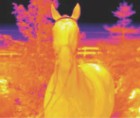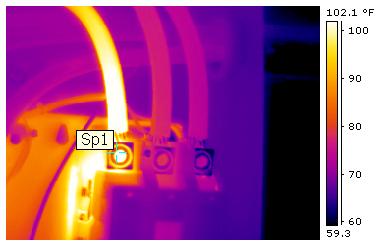- Infrared thermography is the use of an infrared imaging and measurement camera to “see” and “measure” thermal energy emitted from an object. Thermal, or infrared energy, is light that is not visible because its wavelength is too long to be detected by the human eye; it’s the part of the electromagnetic spectrum that we perceive as heat. Unlike visible light, in the infrared world, everything with a temperature above absolute zero emits heat. Even very cold objects, like ice cubes, emit infrared. The higher the object’s temperature, the greater the IR radiation emitted. Infrared allows us to see what our eyes cannot. Infrared thermography cameras produce images of invisible infrared or “heat” radiation and provide precise non-contact temperature measurement capabilities. Nearly everything gets hot before it fails, making infrared cameras extremely cost-effective, valuable diagnostic tools in many diverse applications. And as industry strives to improve manufacturing efficiencies, manage energy, improve product quality, and enhance worker safety, new applications for infrared cameras continually emerge.
A picture says a thousand words; infrared thermography is the only diagnostic technology that lets you instantly visualize and verify thermal performance. Infrared cameras show you thermal problems, quantify them with precise non-contact temperature measurement, and document them automatically in seconds.



Why Use Infrared
Thermography is the use of an infrared imaging and measurement camera to “see” and “measure” thermal energy emitted from an object.
Thermal, or infrared energy, is light that is not visible because its wavelength is too long to be detected by the human eye; it’s the part of the electromagnetic spectrum that we perceive as heat. Unlike visible light, in the infrared world, everything with a temperature above absolute zero emits heat. Even very cold objects, like ice cubes, emit infrared. The higher the object’s temperature, the greater the IR radiation emitted. Infrared allows us to see what our eyes cannot.
Infrared thermograpic cameras produce images of invisible infrared or “heat” radiation and provide precise non-contact temperature measurement capabilities. Nearly everything gets hot before it fails, making infrared cameras extremely cost-effective, valuable diagnostic tools in many diverse applications.
An infrared camera or more accurately a imaging radiometer is a non-contact device that detects infrared energy (heat) and converts it into an electronic signal, which is then processed to produce a thermal image on a video monitor and perform temperature calculations. Heat sensed by an infrared camera can be very precisely quantified, or measured, allowing you to not only monitor thermal performance, but also identify and evaluate the relative severity of heat-related problems.
A picture says a thousand words; infrared thermography is the only diagnostic technology that lets you instantly visualize and verify thermal performance. Our infrared cameras show you thermal problems, quantify them with precise non-contact temperature measurement, and document them automatically in seconds.
Nearly everything that uses or transmits power gets hot before it fails. Cost effective power management is critical to maintaining the reliability of your electrical and mechanical systems. Today, no one would argue the proven predictive maintenance (PM) of infrared thermography and its effectiveness. PM technology quickly, accurately and safely locates problems prior to failure. Finding and fixing a poor electrical connection before a component fails can save you the much greater costs associated with manufacturing downtime, production losses, power outages, fires and catastrophic failures
